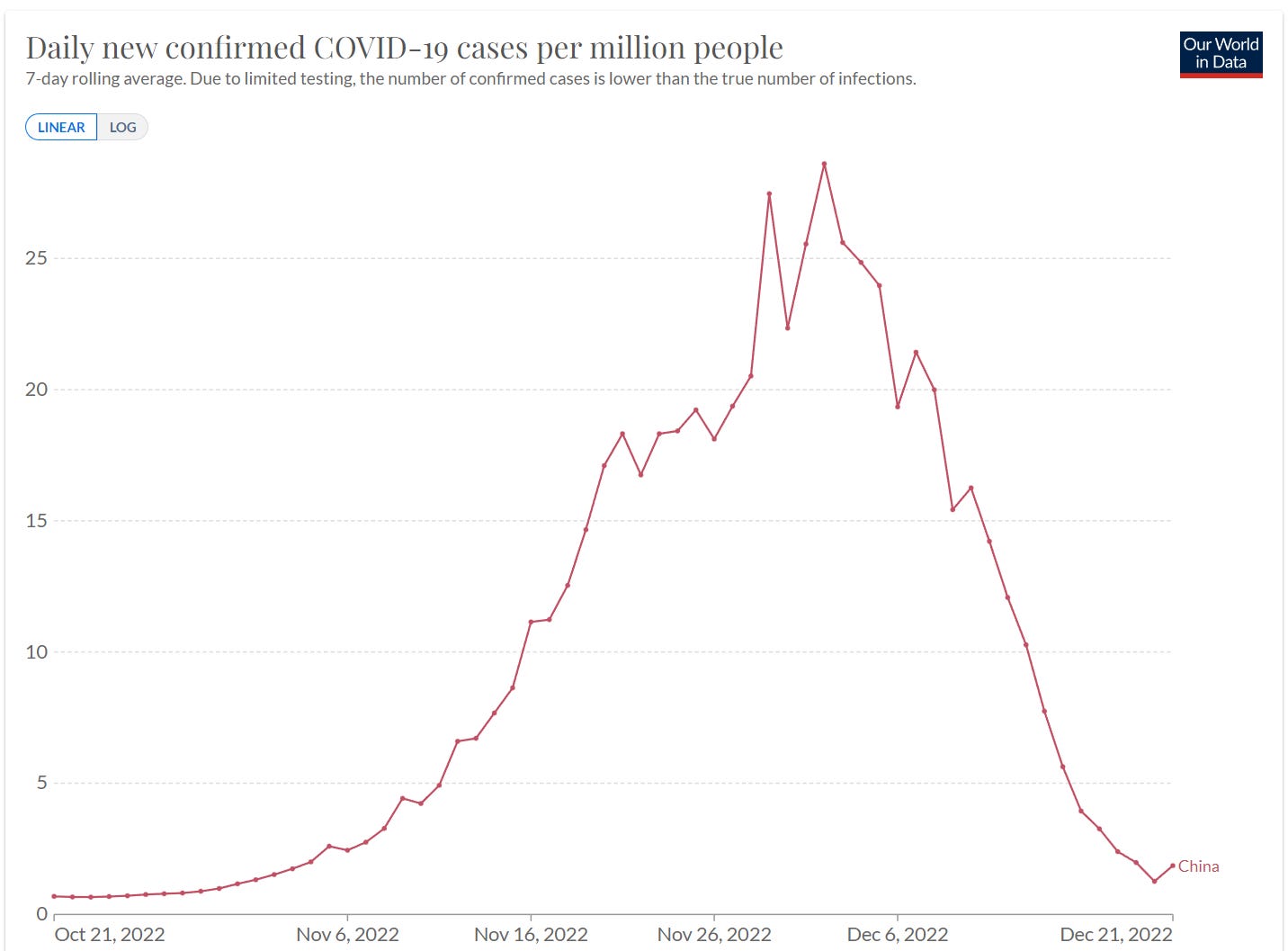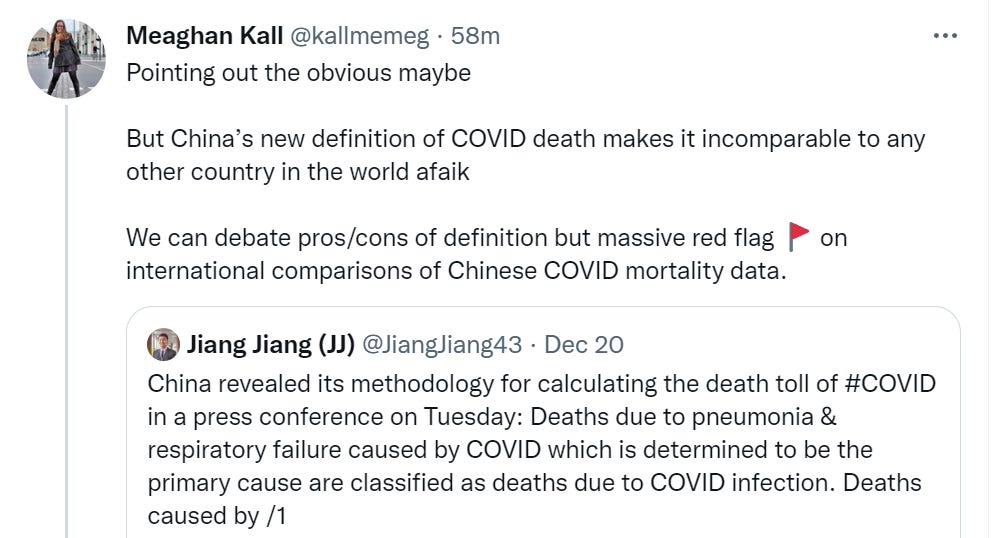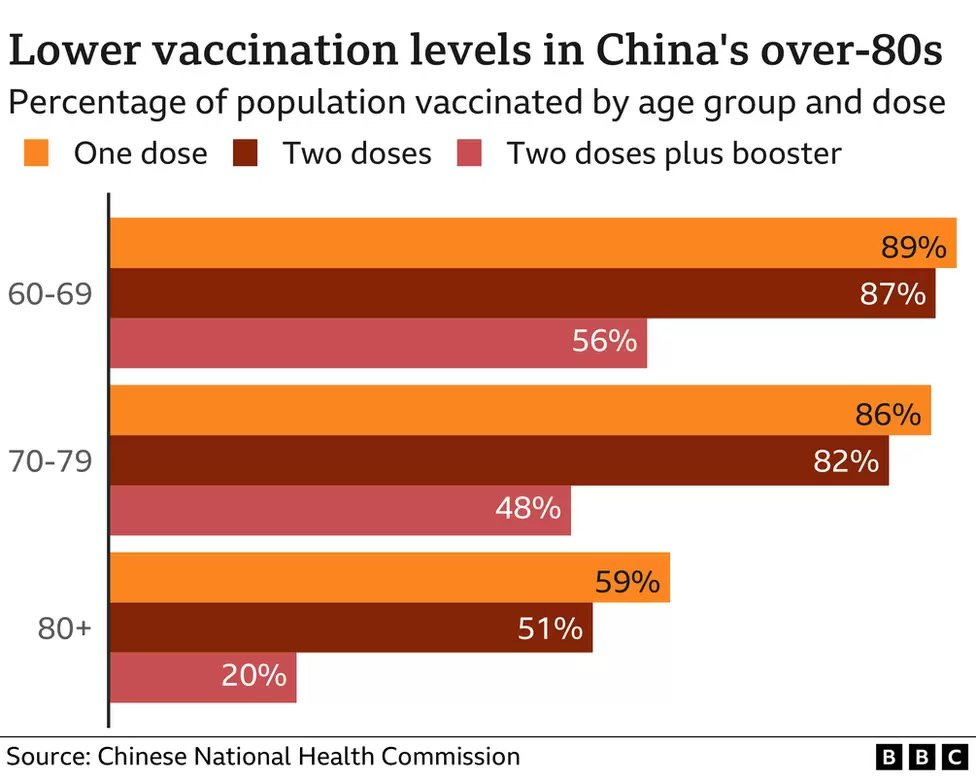China has now decided to let Covid take its course, so it makes sense to spin developments there off into their own posts for a bit. It is hard to get a good read on what is happening, because China’s core strategy was to stop controlling the spread of Covid and instead to put tight controls on its Covid numbers.
You can’t do this while maintaining any credibility. China decided not to let that be a problem.
Please Disregard the Following
The official case numbers in China are now complete nonsense.
Please disregard the following, except to note the need to disregard it after its peak:
You have to love Reuters reporting ‘WHO says China may be struggling to keep a tally of Covid.’ There is no ‘may’ here, nor is there is a struggle. China is choosing not to keep a tally. Or at least, choosing not share it with the rest of us. If China wanted a count, they’d have a count.
China’s official seven day rolling average of deaths at the moment, according to OurWorldInData? One.
Reuters has an article asking how accurate these numbers are, and the correct response is that it is a headline with a question and the answer is simply ‘no,’ and elsewhere they estimate more than 5,000 deaths per day.
Bloomberg agrees and also estimates over a million daily cases, saying this could get ‘even worse’ and rise to 3.7 million cases per day in January. This is the usual ‘oh no exponential growth could get worse, we could have one or even two doublings ahead of us’ style projection, and I’d be worried about numbers closer to 10 million per day, perhaps even somewhat higher.
So how is China reporting one death? Other than ‘with a straight face’?
They did that the same way they solved their reported infections problem.
It’s simple. They’re redefining Covid deaths the same way they redefined cases.
I interpret this as ‘we will look for any way we can to attribute your death to something else, regardless of whether you had Covid at the time.’
Thus:
Letting it Rip
We went very quickly from Zero Covid to Let It Rip.
China's public health officials say that possibly 800 million people could be infected with the coronavirus over the next few months. And several models predict that a half million people could die, possibly more.
…
"Recently, the deputy director of China CDC, Xiaofeng Liang, who' s a good friend of mine, was announcing through the public media that the first COVID wave may, in fact, infect around 60% of the population," says Xi Chen, who's a global health researcher at Yale University and an expert on China's health-care system.
…
Scientists at the China National Health Commission estimate the R number is currently a whopping 16 in China durng this surge. "This is a really high level of transmissibility," Cowling says. "That's why China couldn't keep their zero-COVID policy going. The virus is just too transmissible even for them."
…
Last winter, cases doubled in the U.S. every three days or so. "Now in China, the doubling time is like hours," Cowling says.
…
But Cowling thinks that ultimately China will still fare much better against COVID than America has.
"China has done really well to hold back the virus for three years, and ultimately, I think, the mortality rate will still be much lower than elsewhere in the world," he says, because the country has vaccinated such a high percentage of its population overall. In other words, the death toll will likely be high, given the sheer number of people infected, but it could have been much worse without the vaccinations, he explains.
Almost no one’s brain is capable of understanding what it means for infections to double every few hours, or to react rationally to that situation. I hope that their vaccine, combined with Omicron being milder, softens the blow.
I am skeptical that it’s quite that fast. Still, it’s fast.
This is very not good, except that the available alternatives were likely even worse.
Better to have this happen now, than to inflict a bunch of pain only to have this happen later anyway. China could (and did) sustain the necessary measures for a while, but their people were rightfully losing their patience.
A report from Friday morning (12/16). The Covid-related highlights:
From the comments last week over at LessWrong:
I live in China. I want to verify that most of what Zvi is saying is correct. Things are actually a bit grimmer than he implied. Soon, in late January, there will come the single largest annual human migration known as Chinese New Year. Everyone goes home and visits their relatives, and no one I talked to seemed concerned enough about COVID to cancel their plans. Regardless of what happens before that point, I fully expect 90%+ of Chinese to be infected by mid-February.
So that's, uh, 1 billion people infected in 2 months. I don't know how many ventilators there are in the country, but I've read there are ~200,000 total critical care beds in the entire country, and I doubt there are more ventilators than beds. UPDATE: Estimate found, 80,000.
What are the estimated hospitalization/ventilation rates for an elderly unvaccinated population infected by Omicron? What is the death rate if they don't get on a ventilator? I have no idea how this ends well.
I'm part of a 7-man work group. Over the past 3 days, 2 of us have been part of a 10-person batch that tested positive. We only test once every 3 days. So that's 2/70 people infected in Shanghai right now. Both of my parents are positive. No one really seems concerned and mostly respond with a shrug.
Any idea where I can buy Plaxovid online? If you have any spares, feel free to DM me and name your price. I have elderly family members I'm trying to watch out for.
From 12/21, the BBC reports that Chinese hospitals appear to be filing up.
China has completely reversed course. In several regions, public sector employees are told that if they have Covid and their symptoms are not serious, they should go ahead and come in to work anyway.
Quiet, Too Quiet
No matter how much you officially let it rip, people will always make their own decisions during the peak of the pandemic, and take action to flatten the curve. That doesn’t mean that will be the socially optimal amount of action, but it probably will be distributed more efficiently, and there is no obvious sign that the magnitude is so far off.
Today on the 22nd, Wang reports that Beijing traffic is starting to pick up again, and that there are shortages in basic medical supplies including Tylenol and Advil. If things really are developing with doubling times of a day or less, the timing makes sense, a lot of people have now recovered and can move about freely.
The Six Stages
Was this the plan all along? No. This is what it looks like when the plan fails and now there is no plan. That doesn’t mean it is the wrong approach. Perhaps it was even correct not to have a plan. If you can’t write down the plan worth implementing, you can implement it by not having it be a plan.
China’s actions are not the contradiction they might seem to be. Once you give up on long term full containment, all your incentives transform. Once you no longer are holding everyone’s feet to the fire on local cases, everything changes. You can be in any of a few different modes or stages of the pandemic at any time.
Covid is contained and you are trying to keep it indefinitely contained.
Covid is contained, you are losing that, but you want to lose it slowly.
Covid is not contained, it is growing rapidly, and it is not near its final peak.
Covid is nearing or at its final peak.
Covid is past its final peak and declining.
Covid is endemic.
Your incentives are very different in each of these six steps.
During stage 1, which is ideally what China calls Zero Covid, you are getting a very large payoff from fully containing Covid. It makes sense to do a bunch of extraordinary measures in exchange for not having to deal with Covid more generally. Costs of this have to be balanced against benefits, and it may or may not be worthwhile.
What you do not want to do is attempt to be in Stage 1 without getting the job done, and loosen too much without understanding the consequences. That puts you into Stage 2.
During stage 2, which China was in at least briefly, you are imposing many of the costs of Covid containment generally, and also Covid keeps flaring up requiring large responses. This is the worst of all worlds. It continuously gets worse until you either clamp down enough to get back to Stage 1, or give up and enter Stage 3.
In stage 3, there is no value in containment at all. If you are going to have ten doublings until you get to the top, if the first eight happen every three days instead of every six, this does not make any difference.
Locally, the signs even reverse. If you get sick during Stage 3, you do so when others can help you, both in the medical system and in your life and job, and then you can help others later. Much, much better than getting sick in Stage 4. So ‘come to work sick’ in this phase makes at least some sense, especially if Stage 4 is clearly going to be quite bad. Certainly this is the time of ‘if there is something you want to do or will have a tough time not doing for a while, like seeing your friends or family, you want to do it now.’
The advantage of slowing down stages 2 and 3 is that this buys society time to prepare for stages 4 and 5, which are when things get really bad, society shuts down, hospitals get overwhelmed and people die who didn’t have to.
During stage 4 you absolutely want to do the ‘flatten the curve’ thing, especially focused protection. The key is not to start this too soon, because the actions required are tough to maintain. It’s easy to isolate for a day or even a week, much tougher for a month. So you want to make that time count. Having already done years of Zero Covid in some ways makes the Chinese old veterans able to handle this, and in other ways risks them having zero willingness left to put up with things, especially given that the proper messaging on this is at best rather tricky and plausibly impossible.
Then, once you come out the other end, things return to a new normal. Stage 5 you have some benefit to things normalizing faster, but the worst is over and you likely have little control over things. Then you pick when to fully transition to Stage 6.
China’s key failures were two fold.
It did not use its time wisely, and isn’t prepared.
It kept buying time, at increasingly steep prices, that it wasn’t going to use wisely.
Why was China unable to use its time wisely (Bloomberg)? That post blames it on inability to multitask, that a focus on Zero Covid under authoritarian dynamics ruled out preparing for when this official policy inevitably failed or ended. I think China is perfectly capable of doing two things at once, with the problem that these two things contradict each other on the level of perception. The whole rhetorical strategy was claiming this day would never come, so how do you prepare for it?
I also would hesitate to single out China on this. Did America use its time well? Did Australia? Did anyone else? A fair answer would likely be ‘yes but only in terms of the development of vaccines.’ Which, yes, matters more than everything else combined, yet we would still, in China’s position, not obviously do much better.
If anything, not buying more time now is to China’s credit, if they can’t profit by it.
Now there’s the problem that you want to take your foot off the break and go back to normal until you’re going dangerously or even maximally fast, then hit the breaks at maximum for a few weeks, then mostly go fully back to normal again. That’s hard.
So I sympathize. Given the alternatives, a full sign flip might have been the best option left. I do think the timing is highly unfortunate - doing this in either August or March would have been much better than December. That is another way of illustrating that there was no plan, not even a plan to have no plan. Political realities dominated and forced everyone’s hand, as they often do.
Vaccinations
China’s choice to use their own vaccine was unfortunate. It does seem like they did a reasonable job with persuasion and distribution given they kept it all voluntary. People keep saying that China’s elderly are woefully unvaccinated, yet when I see these numbers they do not look so bad for the 60-79 cohorts.
You can say half of them are not boosted, despite the Chinese having a different vaccine and us having no idea how much a booster matters, but given the lack of coercion, an 82% rate for two shots seems quite good.
The 80+ cohort has much lower numbers, despite much higher risk, including for each shot conditional on the previous one. Presumably this involves some combination of fear of being healthy enough for the virus, and general distrust given what that cohort experienced growing up in China, but I do not know. I have yet to see anyone engage with the rates declining when people get into their 70s and especially 80s.
Here’s how the Washington Post describes this.
China has troubled days ahead. Among those 60 years and older, only about 69 percent have received booster shots, and the uptake is even less among those over 80 years old.
We will never get away from this moralistic framing of Covid, now exclusively in only-boosters-count format. China has troubled days ahead because they held back the virus for so long. They would not be not troubled if only for more delivered booster shots, or even that much less troubled.
Variants Ho?
One big concern is that China letting more than half a billion people get infected over the next month or two could lead to new variants.
This is definitely a real risk. China has about a sixth of the world’s population. This wave won’t be a full sixth of all historical cases, but it won’t be that much less than that. It seems likely that something like 10% of all new-variant risk for the entire pandemic so far is about to happen in China.
How likely is it this results in a major new variant? We have to worry about a new sub-variant of Omicron, or potentially a new meaningful Pi variant. From what I have seen, a new sub-variant of Omicron is unlikely to make that big a difference.
There have been essentially three major variants, where a similar event would be a big deal: Alpha, Delta and Omicron. Risks of this per infection were likely higher earlier in the pandemic, so I’m going to estimate that the chances of this happening due to China are something like 20%.
The good news is that in the majority of those events, it is not that big a deal, the same way that existing sub-variants of Omicron have not been big deals. Yes, the new variant will be more virulent, but that only matters if one is attempting containment. We have given up on that.
We could worry about immune escape from Omicron to various degrees, and we could worry about the virus becoming a lot deadlier. What are the chances of that happening, conditional on a new variant? Not impossible, but given the track record, I’d say something on the order of a 10% chance of a big negative impact.
What Happens Next in China?
China’s decision to ‘go dark’ and proceed with no plan, together with crossing all the points of no return, mostly locks them into letting things take their course even if that course gets quite bad. It seems right to model China’s future as if there will be no central interventions.
That means that we are close to a standard SIR model situation, with all the usual caveats around heterogeneity and geography, starting with almost everyone being susceptible. I do not fully buy that doubling times are starting out on the order of hours, but I buy that we are talking 1-3 days. So what happens? When do things peak?
They likely peak at a level somewhat higher than we saw in America or Europe last winter, without being that much higher. At peak in places like London we were estimating something like 1% of the population being infected per day. With a lot of people hiding away and only 100% of the population available to get infected, my guess is that 2%-3% is the highest that number is going to get in any given city or region. Assuming a quick run up and steady run down, we likely see a peak in early-to-mid January, and life returning to essentially normal around March, fully (new) normal in April or May. If the full estimates of things ripping super fast are true, we might see normal resume in February.
I expect the economic damage from this wave to be relatively minimal, and for it to rapidly be outweighed by the benefits of lifting earlier policies. There are shortages of medicines for obvious reasons, but the Chinese are used to restrictions and lockdowns and logistical problems, and should be able to mostly handle things fine.
This comes down to the human toll: What this does to the health care system in China and for how long, and how many people die of Covid. This part is already ugly and going to get uglier. By all reports the hospitals are already overwhelmed. So we should expect a lot of excess deaths and suffering over the rest of December, all of January and a bunch of February.
If you have the option to be elsewhere, I would be elsewhere. If you cannot, I wish you the best of luck, and advise you to time your period of hiding away as best you can, based on how long a period you can sustain. If you are able to do three or more weeks I would start now pretty much wherever you are in China, if you haven’t yet. If you have less, you’ll have to be more careful, and observe local conditions - starting a few days too early mostly wastes those days.
























A very informative and interesting post, thank you for writing and sharing with us
On China's change in definitions, one estimate was that if USA had used similar definition it would have had 66k covid deaths, not a million. Which puts it in perspective. https://twitter.com/YanzhongHuang/status/1605722378524250114